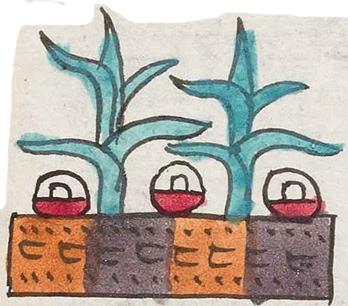Acamilixtlahuacan (Mdz36r)
This compound glyph for the place name Acamilixtlahuacan has three notable elements. The alternating, sectioned, orange-gray or orange-purple band across the bottom is a reference to land, in this case both mīlli (cultivated fields) and ixtlāhuatl) (plains). Sitting atop the land are three upside-down eyes, īxtli, with red lids and white pupils and eyeballs. Only the land is shown in a bird's eye view. Above, the land, in an elevation view, is a pair of turquoise-colored reed plants (ācatl). The locative suffix -cān is not shown visually, but the landscape may represent it.
Stephanie Wood
The eyes (ixtli) are there as a phonetic indicator to underscore the reading of ixtlahuatl) (plains) as opposed to, for instance, tlalli (land). Berdan and Anawalt have suggested that the eyes are intentionally upside down to call forth īxtlapal, which sounds like ixtlahuatl. But Frances Karttunen says that īxtlapal is closer to "sideways" than "reversed" or "inverted." (Source: Frances Karttunen, unpublished manuscript, used here with her permission.)
Symbols on the land, such as dots (seeds?) and u-shapes lying on their sides, open to the right, may refer to the agricultural activity or agricultural potential of the land (given that milli is usually cultivated). Growing out of the land are two turquoise or blue-green reed (acatl) plants. For a slightly different representation of land (tlalli, in this case), see the glyph for Teotlalpan published by the University of California, Berkeley.
Stephanie Wood
acamilyxtlahuacā puo
Acamilixtlahuacan, pueblo (Acamixtla, state of Guerrero, today)
Stephanie Wood
c. 1541, or by 1553 at the latest
Stephanie Wood
Joseph and Crystal Boulton Scott
The reading order starts at the top with aca(tl) (reeds), goes down to mil(li) (agricultural field), back up to ix(tli) (eyes), and then settles on ixtlahua(tl) (plains, which is also represented by the horizontal land rectangle).
plants, eyes, cultivation, fields, agriculture, nombres de lugares

aca(tl), reed, https://nahuatl.wired-humanities.org/content/acatl
mil(li), agricultural field, https://nahuatl.wired-humanities.org/content/milli
ixtlahua(tl), plains, https://nahuatl.wired-humanities.org/content/ixtlahuatl
-can (locative suffix), https://nahuatl.wired-humanities.org/content/can-2
ix(tli), face, eye, surface, https://nahuatl.wired-humanities.org/content/ixtli
tlal(li), a piece of land, a parcel, agricultural field,https://nahuatl.wired-humanities.org/content/tlalli
ixtlapal, sideways, across, from the side,https://nahuatl.wired-humanities.org/content/ixtlapal
"Reed-Bed Plain" [Frances Karttunen, unpublished manuscript, used here with her permission.]
"Place of the Plain of Cultivated Fields of Reeds" (Berdan and Anawalt, 1992, vol. 1, p. 167)
Codex Mendoza folio 36 recto, https://digital.bodleian.ox.ac.uk/objects/2fea788e-2aa2-4f08-b6d9-648c00..., image 82 of 188.
The Bodleian Libraries, University of Oxford, hold the original manuscript, the MS. Arch. Selden. A. 1. This image is published here under the UK Creative Commons, “Attribution-NonCommercial-ShareAlike 3.0 License” (CC-BY-NC-SA 3.0).



